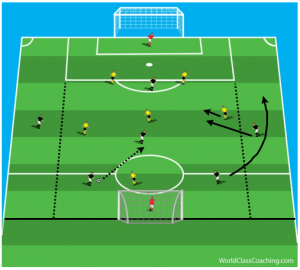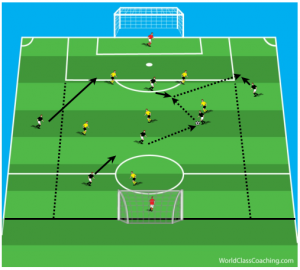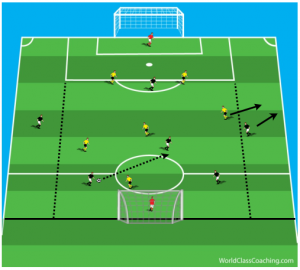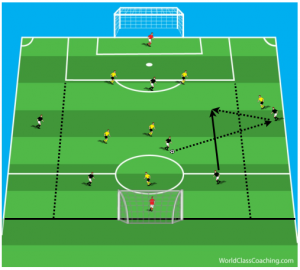By Sean Pearson
Area Size: 2/3 of field with wide zones in line with the 18
Teams: 7 v 7
Time: 20 Minutes
• To understand when to use overlapping runs to advance the ball in wide areas
• To understand when to use underlapping runs to attack centrally
• Decide which run, if any, are the best for the scenario
The area is split in to 3, one main central area with 2 wide zones. The two wide midfield players of the team in possession enter the wide zones as soon as the team wins possession. This is to force your team to use the full width of the field and also adds transition to the game with both teams changing from attacking to defending, allowing more realism. The opposition are allowed in all three zones but are not forced to use them like the team in possession.
For both underlaps and overlaps we will be focusing our attention to the two full backs and the visual cues they should use to understand when and where to perform either run. First we will look at overlaps as these are more common in the game.
To understand when to perform an overlap, firstly when a team wins possession and the wide midfielders move into the wide zones, it is important that the full back sees that there is space to run into ahead of this midfielder. The first visual cue if for the wide midfielder, if the opposition wide midfielder goes with them, this creates space centrally. As the ball travels toward the center midfielder this is the second visual cue for the wide midfielder. They make a diagonal run inside and in front of the opposition, this should draw them with the wide midfielder. As the wide midfielder begins the run inside this is the visual cue for full back to get around the area previously occupied and overlap them (Fig.1). As the wide midfielder comes inside the center midfielder passes the ball into the path of their run (If no opposition comes with them they can run with the ball themselves). The wide midfielder combines with the striker to pass to the overlapping full back
The game of soccer is ever evolving and it is my opinion you have to keep evolving as a coach. Try new ideas, constantly to develop your philosophy and continue to find ways to improve your team and cause problems for others. One way which the game is moving is to use underlapping runs. An underlapping run is able to be performed in very much the same way, however this time the wide midfielder moves away. The visual cue for the full back, if there is an opportunity for an underlapping run, is if the opposition wide midfielder goes with them and no one has entered the space ahead of the full back to utilize. The center midfielder passes in front of the full back and the wide midfielder plays a one time set into the path of the full back to continue their attack.
After both runs have been coached allow the players to use the visual cues learned to perform each run in the correct scenario to advance the ball forwards. Keep in mind that there is a lot being asked of the full backs in terms of energy levels so it is important you swap player positions or your team only aims to perform one of the runs when there is an opportunity to do so.
Coaching Points
- When your team wins possession wide players transition into the wide zones quickly
- Wide players use visual cues to either move infield our further away diagonally to move opposition players out of position.
- Full backs read the decision of the wide midfielder to either perform and overlap or underlap
- Runs must be performed with timing and speed to be successful
By Sean Pearson. Sean is also the author Coaching Team Shape in the 3-3-1, Coaching Team Shape in the 4-2-3-1 and Coaching Team Shape in the 4-3-3






